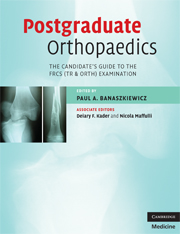Book contents
- Frontmatter
- Contents
- List of contributors
- Foreword by Mr Peter Gibson
- Preface
- Glossary
- Section 1 The FRCS (Tr & Orth) examination
- Section 2 The written paper
- Section 3 The clininicals
- 3 The short cases
- 4 Short case list
- 5 The long cases
- 6 Long case list
- 7 Hand and wrist clinical cases
- 8 Shoulder and elbow clinical cases
- 9 Spine clinical cases
- 10 Hip clinical cases
- 11 Knee clinical cases
- 12 Foot and ankle clinical cases
- 13 Paediatric clinical cases
- Section 4 Adult elective orthopaedics oral
- Section 5 The hand oral
- Section 6 The paediatric oral
- Section 7 The trauma oral
- Section 8 The basic science oral
- Section 9 Miscellaneous topics
- Index
- References
12 - Foot and ankle clinical cases
from Section 3 - The clininicals
Published online by Cambridge University Press: 22 August 2009
- Frontmatter
- Contents
- List of contributors
- Foreword by Mr Peter Gibson
- Preface
- Glossary
- Section 1 The FRCS (Tr & Orth) examination
- Section 2 The written paper
- Section 3 The clininicals
- 3 The short cases
- 4 Short case list
- 5 The long cases
- 6 Long case list
- 7 Hand and wrist clinical cases
- 8 Shoulder and elbow clinical cases
- 9 Spine clinical cases
- 10 Hip clinical cases
- 11 Knee clinical cases
- 12 Foot and ankle clinical cases
- 13 Paediatric clinical cases
- Section 4 Adult elective orthopaedics oral
- Section 5 The hand oral
- Section 6 The paediatric oral
- Section 7 The trauma oral
- Section 8 The basic science oral
- Section 9 Miscellaneous topics
- Index
- References
Summary
Deformities of the foot
Equinus
The entire weight is borne by the forefoot, the hindfoot remaining off the ground. The equinus deformity may be compensatory for either quadriceps or gluteus maximus weakness, or due to shortening of the limb. The equinus deformity may also be caused by contracture of gastrocnemius and/or soleus.
Calcaneus
Here the weight is borne mainly by the hindfoot. The forefoot may have varying degrees of weight bearing, but definitely below normal.
Varus
The weight is borne mainly on the outer side of the foot. This deformity is mainly at the hindfoot.
Valgus
Weight bearing is borne mainly on the inner side of the foot. This deformity is of the hindfoot or of both the forefoot and hindfoot.
Inverted foot
When the hindfoot and forefoot are both in a varus position, the deformity is termed an inverted foot. The accentuation of this position will gradually turn the sole towards the sky – supination of the foot. In these positions, i.e. in inverted and supinated foot, adduction of the forefoot and plantar flexion of the ankle will coexist.
Everted foot
The hindfoot and forefoot are both in a valgus position. The outer part of the sole bears increasingly less weight. In the exaggerated situation, the outer part of the sole acquires a tendency to face towards the sky. In this position, adduction of the forefoot and dorsiflexion at the ankle will coexist.
- Type
- Chapter
- Information
- Postgraduate OrthopaedicsThe Candidate's Guide to the FRCS (TR & Orth) Examination, pp. 110 - 125Publisher: Cambridge University PressPrint publication year: 2008



